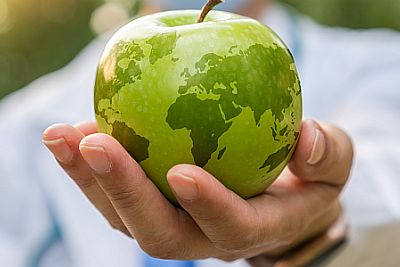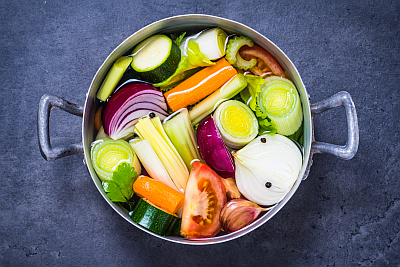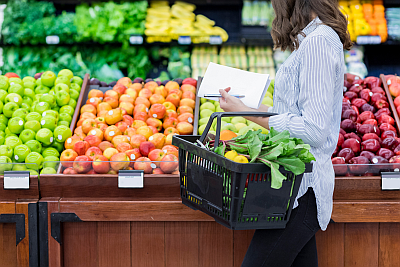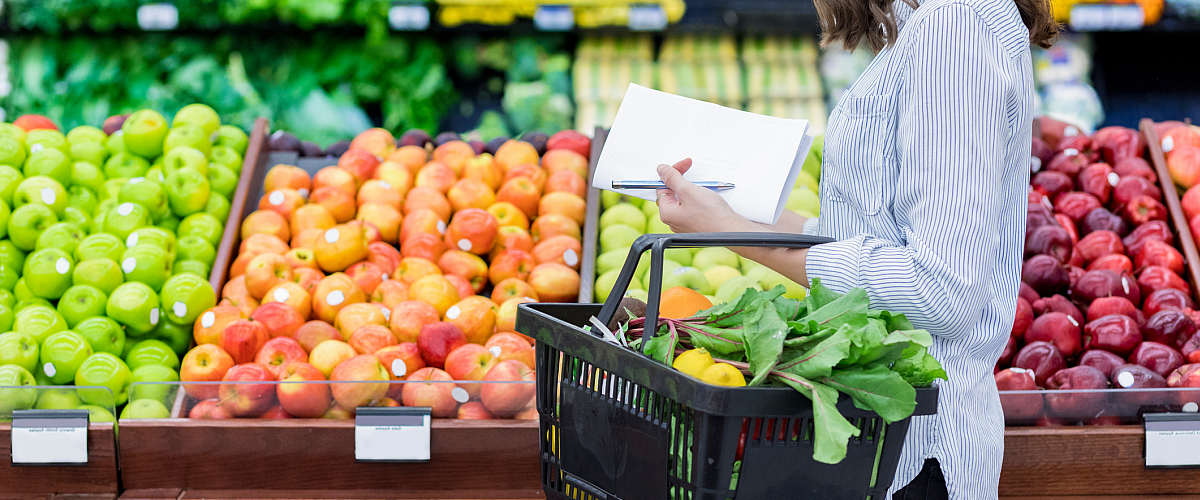You buy a pint of mushrooms at the grocery store, but they get moldy before you can eat them. Your leftovers sit in the back of the fridge, only to be discovered a couple of weeks later in not-so-good shape. A glass of milk gets poured and forgotten on the counter, so it gets poured again—this time down the drain.
Food waste can happen for many reasons, and despite our best intentions. A little wasted food in your kitchen is a little problem. But when you add it up across millions of kitchens, it quickly becomes a big problem with big environmental impact. The good news is that this is a problem that’s getting attention. There are experts who are focused on helping us reduce food waste wherever it happens.
 We connected with the Aramark Sustainability team, who work with the food waste reduction pros—our chefs and food production managers who are discovering new waste reduction strategies and preventing millions of pounds of food waste each year. Read on to learn more about food waste—and how we can all be part of the solution.
We connected with the Aramark Sustainability team, who work with the food waste reduction pros—our chefs and food production managers who are discovering new waste reduction strategies and preventing millions of pounds of food waste each year. Read on to learn more about food waste—and how we can all be part of the solution.
A Global Problem
The issue of food waste extends far beyond your home kitchen. When extra food winds up in a landfill, or goes down the drain, or is left unharvested in the fields—it all counts as food waste. In 2019, about 35 percent of all food in the U.S. went unsold or uneaten.
When food goes to waste, we pay for it five times over—in labor, energy, water, transportation costs, and even carbon emissions. In fact, wasted food accounts for about four percent of our country’s greenhouse gas emissions.
9 Ways to Fight Food Waste at Home
Our chefs and food production managers are committed to fighting food waste in the locations we serve and are employing a variety of strategies to tackle this issue. Their success provides a good roadmap for you to follow in your own kitchen.
The best way to reduce food waste is to avoid creating it in the first place. Here are some tips for wiping out waste at home—little steps that can have a big impact and help the planet while also saving money (always a welcome benefit)!
- Make a list. Before you go shopping, figure out what your household needs and how much. Then stick to the list! Buy only what you know you will use in the coming days or week, so it doesn’t have a chance to spoil. If you find that your fresh food purchases are often going bad before you can eat them, choose canned, frozen, or shelf-stable foods. They offer the same nutrition but will last much longer than fresh versions.
- Store it right. You can get more life out of certain foods just by putting them in the right place. Do your fruits and veggies belong in the fridge, in the pantry, or on your countertop? Turn to this guide from the American Heart Association to find out.
- Prep and plan ahead. When foods are convenient, we’re more likely to eat them. Slice and dice your fresh produce so it’s ready for snacking and for using in recipes. That extra effort will decrease the chance that the food goes to waste.
-
 Shop your stash. Need some mealtime inspiration? Look around your kitchen to see what’s on hand, then build out recipes from there. Dishes like soups, salads, and smoothies are great ways to use whatever produce you have lying around, even if the ingredients are just a little past their prime.
Shop your stash. Need some mealtime inspiration? Look around your kitchen to see what’s on hand, then build out recipes from there. Dishes like soups, salads, and smoothies are great ways to use whatever produce you have lying around, even if the ingredients are just a little past their prime. - Save the date(s). It’s easy to be intimidated by the wide variety of codes and date messages stamped on food packages. What does “sell by,” “use by,” “best if used before,” and “freeze-by” really mean? Often, these labels are not safety dates. Rather, they tell us when a product is at its peak quality. As long as you don’t notice any signs of spoilage, the food is probably fine to eat. Below, the USDA elaborates on how to keep all the dates straight.
- Best If Used By/Before: When a product will have the best flavor or quality. They don’t have anything to do with safety or when the food should be sold.
- Sell By: Tells the store how long to display a product for sale. They are also not a safety-related date.
- Use By: The last recommended date to eat something if you’re looking for peak quality. This only pertains to safety with infant formula.
- Freeze By: When a product should be frozen to maintain top quality. You may be able to buy and eat it past then.
- Put it on ice. If you can’t finish food before it goes bad, put those leftovers in the freezer. This appliance is your workhorse for preventing food waste. Almost any food can be safely frozen. Label it with the contents and the date, so you can look forward to eating it another time.
- Donate it. If you can’t use the food, give it to someone who can. Donating food reduces waste while also helping out people facing food insecurity in your community.
 Talk about it. Food waste and food insecurity are big topics, but not so big that you should avoid discussing them at home. Learning to minimize food waste can and should start at a young age. For instance, teach children by serving appropriate portions of food and eat what’s on their plate—and of course, try to lead by example.
Talk about it. Food waste and food insecurity are big topics, but not so big that you should avoid discussing them at home. Learning to minimize food waste can and should start at a young age. For instance, teach children by serving appropriate portions of food and eat what’s on their plate—and of course, try to lead by example.- Compost it. Composting helps the environment twice over by turning food scraps into soil you can use in your lawn or garden. A good rule of thumb: Anything that was once living is compostable. You can build a home composting system indoors or outdoors. The Environmental Protection Agency (EPA) has a guide to get you started.
Waste Not, Want Not
We all share this planet, and everyone has a role to play in reducing food waste. Know that these small steps can collectively make a big difference. When we all start believing that our individual efforts matter, that’s how we bring about real change.
And did you know? With our ingredient list auto-calculator, you can customize any of our recipes to the exact number of servings you need, which is yet another way to prevent food waste.
Whether you’re dining solo or feeding a crowd, it’s easy to see exactly how much of each ingredient you’ll need. Our chefs are adding new recipes all the time, so head on over and try something new—and savor every bite.
Note: Since everyone’s health history and nutritional needs are so different, please make sure that you talk with your doctor and a registered dietitian to get advice about the diet and exercise plan that‘s right for you.

